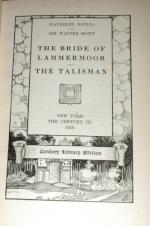Caleb, however, furnished the notables of Wolf’s Hope with a note of the requisition of butter and eggs, which he claimed as arrears of the aforesaid subsidy, or kindly aid, payable as above mentioned; and having intimated that he would not be averse to compound the same for goods or money, if it was inconvenient to them to pay in kind, left them, as he hoped, to debate the mode of assessing themselves for that purpose. On the contrary, they met with a determined purpose of resisting the exaction, and were only undecided as to the mode of grounding their opposition, when the cooper, a very important person on a fishing-station, and one of the conscript fathers of the village, observed, “That their hens had caickled mony a day for the Lords of Ravenswood, and it was time they suld caickle for those that gave them roosts and barley.” An unanimous grin intimated the assent of the assembly. “And,” continued the orator, “if it’s your wull, I’ll just tak a step as far as Dunse for Davie Dingwall, the writer, that’s come frae the North to settle amang us, and he’ll pit this job to rights, I’se warrant him.”
A day was accordingly fixed for holding a grand palaver at Wolf’s Hope on the subject of Caleb’s requisitions, and he was invited to attend at the hamlet for that purpose.
He went with open hands and empty stomach, trusting to fill the one on his master’s account and the other on his own score, at the expense of the feuars of Wolf’s Hope. But, death to his hopes! as he entered the eastern end of the straggling village, the awful form of Davie Dingwall, a sly, dry, hard-fisted, shrewd country attorney, who had already acted against the family of Ravenswood, and was a principal agent of Sir William Ashton, trotted in at the western extremity, bestriding a leathern portmanteau stuffed with the feu-charters of the hamlet, and hoping he had not kept Mr. Balderstone waiting, “as he was instructed and fully empowered to pay or receive, compound or compensate, and, in fine, to age as accords respecting all mutual and unsettled claims whatsoever, belonging or competent to the Honourable Edgar Ravenswood, commonly called the Master of Ravenswood——”
“The right Honourable Edgar lord Ravenswood,” said Caleb, with great emphasis; for, though conscious he had little chance of advantage in the conflict to ensue, he was resolved not to sacrifice one jot of honour.
“Lord Ravenswood, then,” said the man of business—“we shall not quarrel with you about titles of courtesy—commonly called Lord Ravenswood, or Master of Ravenswood, heritable proprietor of the lands and barony of Wolf’s Crag, on othe ne part, and to John Whitefish and others, feuars in the town of Wolf’s Hope, within the barony aforesaid, on the other part.”




